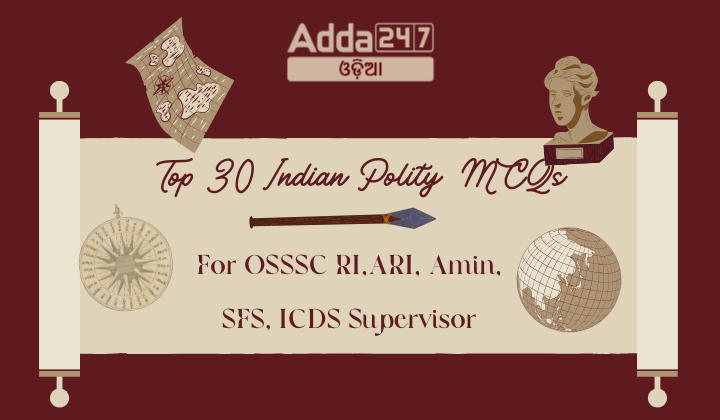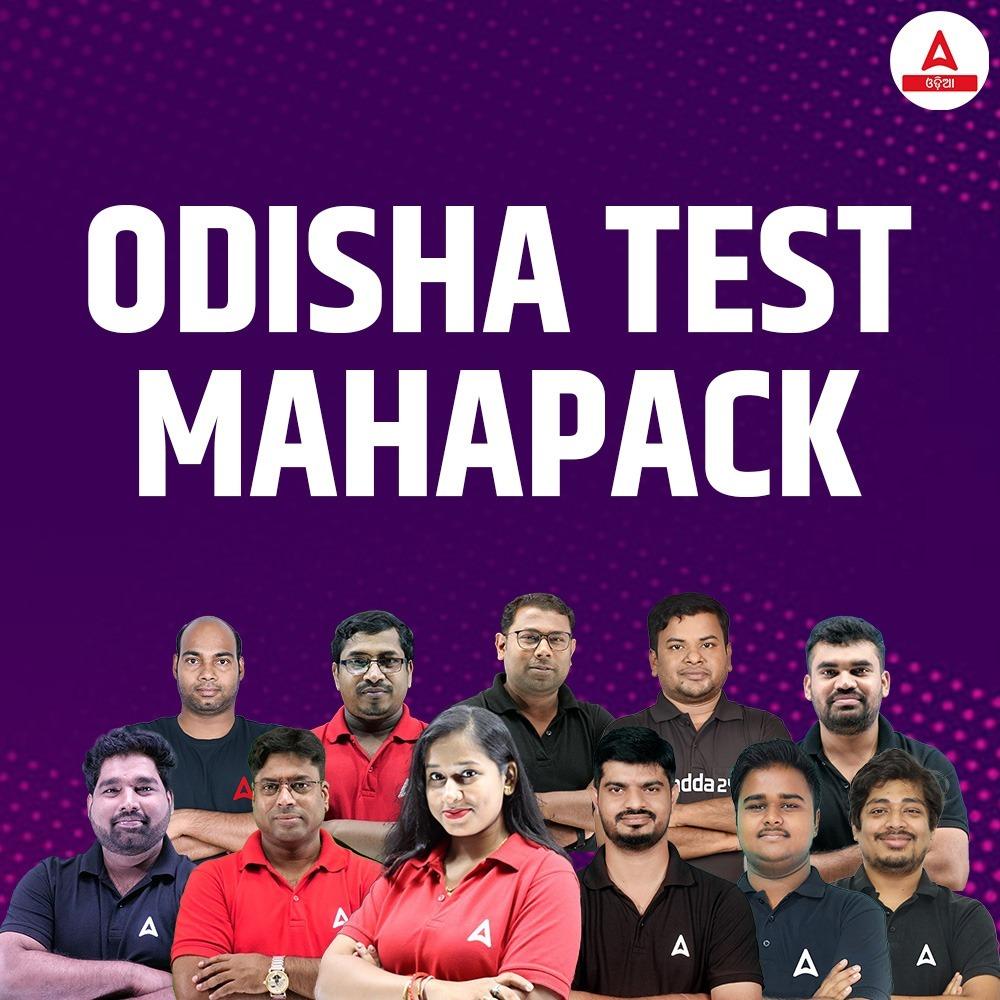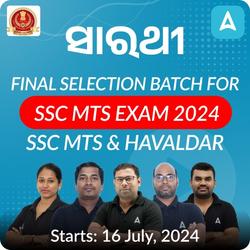Indian Polity is a crucial section for competitive exams like OSSSC RI, ARI, Amin, SFS, and ICDS, where a solid understanding of the Indian Constitution, political institutions, and fundamental principles of governance is tested. Top MCQs often cover essential topics such as the features and significance of the Preamble, the fundamental rights and duties of citizens, and the Directive Principles of State Policy. Questions might delve into the structure and functioning of the Parliament, including the roles of the Lok Sabha and Rajya Sabha, the process of law-making, and the nuances of parliamentary procedures. The examination can also include queries about the President’s and Governor’s powers, the Council of Ministers, and the Prime Minister’s role in the executive branch. The federal structure of India, including the distribution of powers between the Centre and States, the role of the Judiciary, the appointment and functions of the Supreme Court and High Courts, and the process of judicial review, are critical areas frequently explored in these MCQs.
Top 30 Indian Polity MCQs for OSSSC RI,ARI, Amin, SFS, ICDS Supervisor
- Who drafted the Sedition law?
(a) Thomas Babington Macaulay
(b) James Fitzjames Stephen
(c) Claire Ward
(d) None of the above
Ans: (a)
Explanation: Thomas Babington Macaulay drafted the Sedition law. - In which year was the Sedition law passed?
(a) 1886
(b) 1902
(c) 1820
(d) 1870
Ans: (d)
Explanation: The Sedition law was passed in 1870. - Which Section of the IPC deals with Sedition?
(a) Section 124
(b) Section 124 A
(c) Section 307
(d) Section 302
Ans: (b)
Explanation: Section 124 A of the IPC deals with Sedition. - The first recorded trial under Section 124A of the sedition law in India was against _____.
(a) Jogendra Chandra Bose
(b) Mohammad Ali Jinnah
(c) Kedar Nath Singh
(d) K.M. Munshi
Ans: (a)
Explanation: The first recorded trial under Section 124A of the sedition law in India was against Jogendra Chandra Bose. - Jogendra Chandra Bose was the editor of which of the following newspapers?
(a) Bangobasi
(b) Madras Courier
(c) Indian Gazette
(d) Bombay Herald
Ans: (a)
Explanation: Jogendra Chandra Bose was the editor of Bangobasi. - Who was the first person to be convicted under Sedition?
(a) Subhash Chandra Bose
(b) Mahatma Gandhi
(c) Bal Gangadhar Tilak
(d) Sardar Vallabhbhai Patel
Ans: (c)
Explanation: Bal Gangadhar Tilak was the first person to be convicted under Sedition. - The judge who sentenced Lokmanya Tilak to imprisonment in 1908 also happened to be the lawyer arguing Tilak’s case in a similar trial in 1897. Who was he?
(a) Justice Dinshaw Davar
(b) Justice Mehr Chand Mahajan
(c) Harilal Jekisundas Kania
(d) Mandakolathur Patanjali
Ans: (a)
Explanation: Justice Dinshaw Davar sentenced Lokmanya Tilak to imprisonment in 1908. He argued for Tilak in a similar case in 1897. - Sedition is a ______.
(a) Bailable offence
(b) Non-bailable offence
(c) Cognizable offence
(d) Statutory criminal offence
Ans: (b)
Explanation: Sedition is a non-bailable offence. - What is the punishment under Sedition law?
(a) Imprisonment up to three years
(b) Lifetime imprisonment
(c) Fine
(d) All of the above
Ans: (d)
Explanation: Under Sedition law, punishment varies from up to three years to life imprisonment. A fine can also be imposed. - In which countries has Sedition law been abolished?
(a) South Korea
(b) Scotland
(c) Ghana
(d) All of the above
Ans: (d)
Explanation: Various countries in the world have abolished Sedition law including South Korea, Scotland, Ghana, and Indonesia. - The National Commission to Review the Working of the Constitution (NCRWC) was set up in which year?
(a) 1998
(b) 2000
(c) 2002
(d) 2004
Ans: (b) 2000 - Who headed the NCRWC?
(a) K. Subba Rao
(b) Y.V. Chandrachud
(c) M.N. Venkatachaliah
(d) P.B. Gajendragadkar
Ans: (c) M.N. Venkatachaliah - The NCRWC was required to submit its report within what timeframe?
(a) Six months
(b) One year
(c) Two years
(d) Three years
Ans: (b) One year - Which of the following was a primary task of the NCRWC?
(a) To rewrite the Constitution
(b) To review the working of the Constitution
(c) To implement new laws
(d) To conduct General Elections
Ans: (b) To review the working of the Constitution - The NCRWC submitted its report in which year?
(a) 2001
(b) 2002
(c) 2003
(d) 2004
Ans: (b) 2002 - One of the areas studied by the NCRWC was:
(a) Reforming the education system
(b) Strengthening of parliamentary democracy
(c) Abolishing the judiciary
(d) Privatization of public sector
Ans: (b) Strengthening of parliamentary democracy - Which constitutional amendments were noted by the NCRWC for widening the democratic debate base?
(a) 42nd and 44th Amendments
(b) 52nd and 73rd Amendments
(c) 73rd and 74th Amendments
(d) 86th and 93rd Amendments
Ans: (c) 73rd and 74th Amendments - What was a major political failure identified by the NCRWC?
(a) High literacy rates
(b) Effective electoral processes
(c) Criminalization of politics
(d) Stable governments
Ans: (c) Criminalization of politics - The NCRWC’s recommendations were:
(a) Binding on the Parliament
(b) Advisory in nature
(c) Automatically implemented
(d) Rejected by the Parliament
Ans: (b) Advisory in nature - Which sector saw impressive growth according to the NCRWC’s observations from 1950-2000?
(a) Industrial and service sectors
(b) Agriculture only
(c) Public health only
(d) Judicial system
Ans: (a) Industrial and service sectors - Which of the following figures is associated with the slogan ‘Inquilab Zindabad’ that has contributed to India’s national consciousness?
(a) Mahatma Gandhi
(b) Rani Laxmi Bai
(c) Bhagat Singh
(d) Lal Bahadur Shastri
Answer: (c) Bhagat Singh - Which organization designs the school syllabus that contributes significantly to shaping the idea of India?
(a) UGC
(b) AICTE
(c) NCERT
(d) CBSE
Answer: (c) NCERT - What is the approximate percentage of India’s population that has access to higher education?
(a) 25-26%
(b) 50-51%
(c) 12-13%
(d) 87-88%
Answer: (c) 12-13% - Which university is mentioned as having a diverse student population contributing to a pan-Indian sense of unity?
(a) Harvard University
(b) Osmania University
(c) Oxford University
(d) Tokyo University
Answer: (b) Osmania University - What percentage of people in the USA have access to higher education?
(a) Approximately 25%
(b) Approximately 50%
(c) Approximately 87%
(d) Approximately 12%
Answer: (c) Approximately 87% - Which Prime Minister of India emphasized the importance of right education for all as a remedy for national issues?
(a) Lal Bahadur Shastri
(b) Jawaharlal Nehru
(c) Indira Gandhi
(d) Rajiv Gandhi
Answer: (b) Jawaharlal Nehru - Which sport has united Indians across different sections of society?
(a) Hockey
(b) Cricket
(c) Football
(d) Tennis
Answer: (b) Cricket - Who among the following authors wrote patriotic literature that promoted Indian nationalism during the freedom struggle?
(a) Salman Rushdie
(b) Arundhati Roy
(c) Rabindranath Tagore
(d) Vikram Seth
Answer: (c) Rabindranath Tagore - Which city is noted for having a population from every region of India, reflecting the idea of national integration?
(a) Chennai
(b) Delhi
(c) Mumbai
(d) Hyderabad
Answer: (c) Mumbai - What role has the press/media played in India’s national integration?
(a) Promoting regionalism
(b) Furthering communal divides
(c) Strengthening national unity
(d) Limiting freedom of expression
Answer: (c) Strengthening national unity





